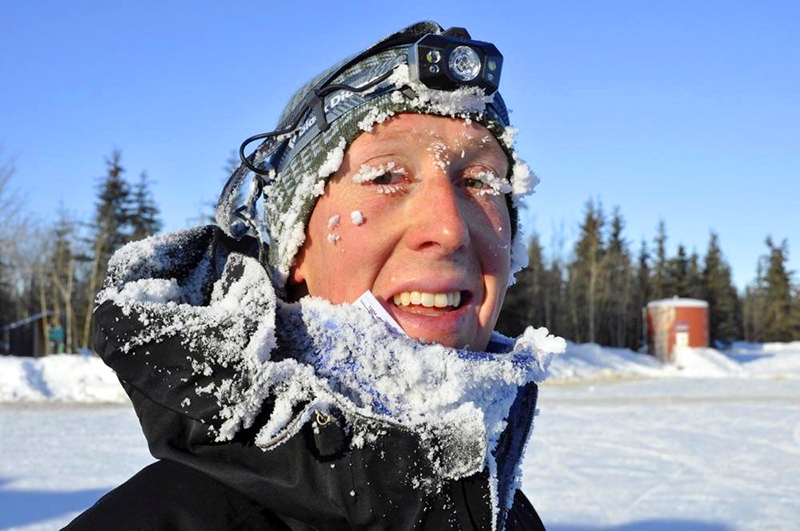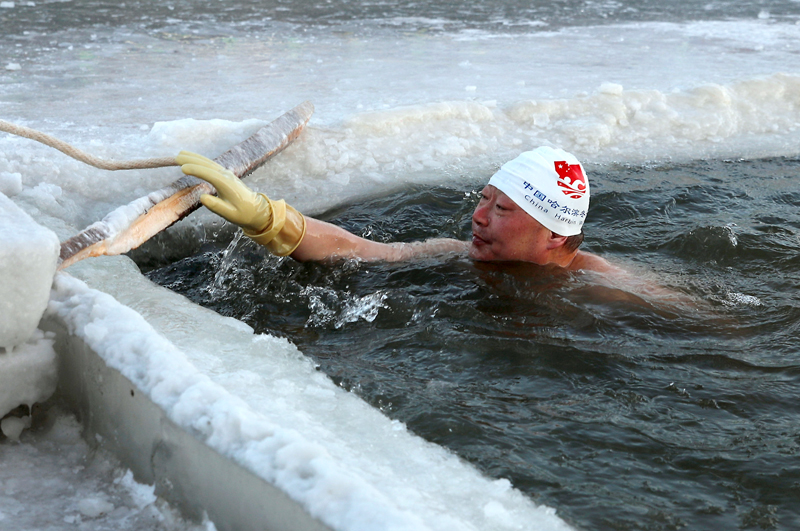
There are three types of cold injuries: hypothermia, freezing injuries, and non-freezing injuries. Full-blown hypothermia occurs when the body can’t produce as much heat as it’s losing and its core temperature drops below 35°C. However, mild hypothermia (a body core temperature of 37°C to 35°C) still feels extremely cold and can easily sneak up on you – for example when you’re exposed to a combination of wet and windy conditions that you weren’t expecting.
For instance, supposing you’re out for a long training ride on the bike, which starts off sunny but ends in April showers. By the end of the ride, you may well be shivering like mad, and feeling sluggish with hands and feet that are so cold it’s almost impossible to turn the key in the front door! The best cure for this is to get into dry clothes and under some blankets as soon as possible and drink a cup or two of your favourite non-alcoholic hot beverage.
If you puncture your last inner tube and have to walk back in the wet and cold, hypothermia can quickly progress to the moderate stage. Your body temperature can fall below 35°C and you may stop shivering. Your speech is slurred; fingers, lips, and toes are blue; you feel very foggy; and you are having difficulty with movement. At this stage, you won’t be making rational choices and you’ll probably need to rely on someone else to get you warm and dry.
As the sun goes down and temperatures begin to drop, you could well find yourself in an emergency situation. If someone finds you in severe hypothermia with a core temperature below 32°C, they should not attempt to move you since you are now at risk for fatal cardiac arrhythmias (disruption to heart rhythm). Emergency personnel should be called immediately. Hopefully your rescuer will have brought along some blankets to cover you until medical attention arrives. At this point, resuscitation should be left to the professionals.
Prevention rules
Whether this scenario becomes reality will depend on whether you follow the rules of prevention(1)! You should be aware that in cold weather, you won’t feel as thirsty as usual, and you’ll urinate more, which means you still drink as you normally would, even though your needs are increased. It’s also a fact that a previous cold injury makes you more likely to experience another episode. Moreover, you should be aware that your team mates who are female, extra lean, at junior or masters level, or of African descent, are at greater risk for cold injuries. It’s good practice therefore to watch your team mates for signs of the ‘umbles’ that might signify hypothermia: stumbles, mumbles, fumbles, and grumbles(2).As a rule of thumb, you should always evaluate the weather forecast before setting off and dress in layers to increase your warmth and flexibility. Your base layer should be made of a moisture wicking material, over which you should wear an insulating fleece or wool layer. Wear or pack a water resistant windbreaker to guard against the possibility of a spring squall. If it’s windy, a light pair of glove liners can help keep fingers from feeling cold.
If the wind chill is significant, a pair of mittens worn over the top provides extra warmth, while still enabling you to keep your fingers toasty warm if you have to pull off the mittens to adjust your shoes or change a tyre. If the forecast looks poor, try to use known routes with resources for shelter or warming, and travel with a pal. Always take a mobile phone!
Frostbite
Frostbite occurs when the body attempts to maintain the core temperature by shunting blood from the extremities to the core. As frostbite begins, the skin freezes, then the water outside the cells just under the skin, then the cells themselves. The skin looks dry, waxy, red and swollen. There may be a tingling or burning sensation. As frostbite progresses to its severe form, the tissue below the skin, including muscle, tendon, and bone also freeze. The skin looks hard and cold, can be white/grey to black/purple in colour, and is painful.Frostbite progresses from the hands, feet, nose and ears, toward the centre of the body and usually occurs only if the ambient air temperature is below 0°C. However, if the skin is wet and exposed to heavy winds, frostbite can occur at slightly higher temperatures(3). Unless you are participating in true winter sports, you are not likely to experience frostbite. However, if you train in an area where weather can be unpredictable and temperatures drop suddenly, it is always best to be prepared with an extra pair of dry socks, glove liners, and maybe even a ski mask.
Non-freezing injuries
The average athlete out for spring training is more vulnerable to non-freezing injuries such as trench foot and chilblains. Both are inflammatory processes that result from exposure to cold, wet conditions. Trench foot occurs when the feet are exposed to temperatures between 0°C and 15°C over a long period of time, either submerged in water for more than 12 hours or in a sweaty or wet shoe worn for several days. The foot initially appears swollen, red and numb, and as the condition progresses, may appear pale or blue and feel quite painful.Since spring training often means running or biking in the rain or through puddles, you should change socks frequently if you are out for more than a few hours. If you have excessively sweaty feet, try treating them with antiperspirants before training. Above all, have an extra pair of shoes or if you only have one pair, make sure they’re dry before putting them on for your next training session.
Chilblain is a more superficial injury and takes less time to develop than trench foot. After just one hour of exposure to wet, cold conditions at temperatures below 16°C, small red bumps can occur on the surface of exposed skin. The lesions are tender and itchy, and as the skin warms, become inflamed, red, and painful. Treatment is to re-warm the area with dry loose clothing or blankets. Do not apply any topical creams or lotions, simply cover and avoiding friction or popping of any blisters. Chilblain usually resolves without consequence, but you should seek medical attention if circulation and sensation do not resolve in 12-24 hours.
Cold air
Up to 50% of elite athletes experience some degree of exercise-induced bronchoconstriction (EIB)(3). This narrowing of the lung’s airways can be triggered by exercise in people with asthma, and also by cold exposure, producing asthma-like symptoms in people not diagnosed with asthma. Researchers believe that the resulting airway inflammation is due to either breathing in dry air at a faster rate during exercise, cooling of the exposed skin on the face and neck, or pollutants in the air(3). Regardless of the cause, any time your breathing is affected, your performance can suffer as a result. The best way to prevent cold-induced EIB is to cover exposed skin on your head and neck and wrap a handkerchief over your mouth.Anyone living in a valley area may experience cold weather inversion patterns during the winter and early spring. When the warm air traps cold air below it, the pollution also becomes trapped and concentrated (see figure 1). Training in conditions of cold and poor air quality can trigger EIB, so if you find yourself plagued by it, think about the air quality where you’re training and consider heading for the hills.
It’s easy to get cocky when the weather starts to warm up. Having survived the winter just fine, it’s easy to be lulled into thinking that it’s no big deal to get caught out without a jacket for a few hours. And to a degree, you are right because humans can acclimatise to cold. However, to do so requires more than eight hours of exposure to cold temperatures every day, for more than two weeks(3). And even after intense habituation, the gains made toward tolerating lower body temperatures are small.
After acclimatisation, some people develop an exaggerated shivering response, which produces more metabolic heat when the body is cold. Others find that their bodies react to acclimatisation by enhancing the body heat preservation mechanism, which decreases the blood flow to the extremities and keeps the core warm. No matter how your body reacts, it takes repeated, supervised exposure to make small gains in tolerance. Unless you have undergone such a programme, pack a jacket and an extra pair of socks.
Summary
The best way to survive during spring training is to hope for the best, but plan for the worst. Be prepared by understanding the typical weather patterns in your area and dress accordingly. Always train in familiar areas where you can easily locate a place to duck in out of the rain or warm up for a while. Alert someone to where you will be and when you are expected home, and if you can, train with a friend.References
1. J Athl Train. 2008 December;43(6):640-658
2. US Army Centre for Health and Preventative Medicine; Nov. 2006: Cold Injuries Training Presentation.
3. Med Sci Sports Exerc. 2006 Nov;38(11):2012-29









